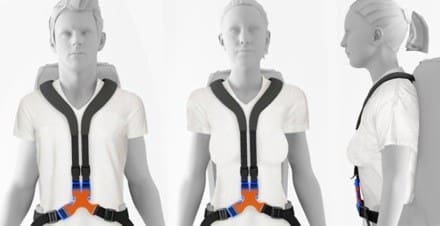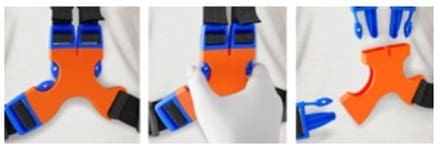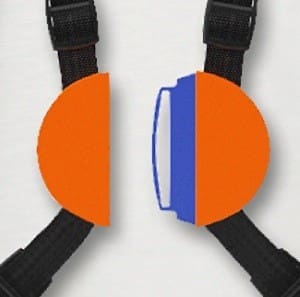Swedish firm coXa carry AB has developed a new integrated front suspension design that integrates the shoulder and waist straps into a single buckle hub. Growing up, inventor Claes Bergkvist was a Scout and took his backpacking seriously. As he grew up, he came upon this concept. After working with several international firms to develop the design (including Duraflex) he was granted a patent last year.
In addition to introducing a line of packs, they are also looking for licensees of this technology. Above and below you can see different design concepts for this ergonomic backpack carrying system. One distinct advantage is that it frees your arms up quite bit as well as the waist which may well transfer to increased mobility.
Tags: coXa carry





Genius! I’d think this would be perfect to mount to something like a Tactical Tailor removable operator pack. Perfect size to try out a cool new concept like this. This looks like it would also be great to clear up any interference when shouldering a rifle while hunting with a pack.
I’ve got a 19″ neck and traps up to jaw line.. that would purely suck.
Do you even lift, bro?
Hahahah ^
Best statement I’ve heard today.
Good design for civilian applications. Reminds of the 4-point design from race car seat belt harnesses. However, even with a single point of failure for your entire pack system aside, I can see the shoulder strap buckle design, which requires donning over the top of the head, would be terrible for military applications for several reasons.
What do you mean over your head?
It could just be the smaller picture on the right, but it give the appearance that the top buckle is one piece, requiring the user to pull the straps over the head. IF, in fact, that center buckle is two separate pieces than I can see some real value in this type of harness, especially if it could be ruggedized and then add a quick ditch feature that would allow the user to dump the entire pack at a single point, just like the buckle system in a 4-point race harness. The current ruck pack systems require a minimum of two separate quick disconnect points, one on the waist and the other on the strong side strap release by the weak side hand.
From the looks of you can detach everything with just one hand and one push, the buckles look like they snap in at 3 points and all 3 points are close enough together that you should be able to press on all 3 at the same time. In theory this should work well as a quick release since only 1 strap will be connected to the central buckle which should allow the pack to fall right off.
Spartan, I totally agree with your conclusion. For civilian recreational activities this should be nice, but real TACTICAL operation usefuls I don’t see it as useful.
Bwahaha! I am laughing so hard! Thank you for making my day.
Yeah, I don’t see the usefuls as useful either. Totally.
I think it might get somebody thinking. Maybe THIS isn’t the answer, but what we are doing right now isn’t optimal either.
What if it was just a tactical operation, as opposed to a full-on TACTICAL operation?
Looks just like the seat harness in UH-60s.
I’m sorry. I just keep staring at the middle picture.
This product needs to be immediately modeled by each of the Hot Shots calendar subjects. Preferably attired appropriately for through evaluation of user experience.
Looks nice in the rendering, but I do not think it would translate very well into real world application…
1. the sholder harness would lift the hip belt
2. bend over and the pack is now under your backside
3. the kiddy carseat buckle does not have the breakstrength
4. the wiggley shoulder harness looks cool but would have to be pretty stiff
cool in concept
To my best knowledge never worked for Duraflex USA…
What keeps the shape of the horse collar bend in the straps going around the neck? Weight will just want to straighten them and so will shock, so it will be moving around over your shoulders and pecs? I’d have to see it in action. I’d think it’d need a Y buckle up by the sternum similar to what’s used in a 5 pnt. harness to keep the should strap elongation in check?
Finally, someone is thinking and asking the right questions.
Ditto … I don’t see how this design works unless the over-the-shoulder bits are inflexible or you add a sternum Y-buckle.
The effectiveness of a waist belt comes from its isolation from other load-bearing elements (e.g. shoulder straps). It looks as if putting an upward load on the middle portion of the waist belt would change the geometries and physics of the whole system, thus part of the reason why it hasn’t been done before. No matter the % of load carried on the waist belt, it can never be 100%, and there will always be an upward force
It might be the next new thing in ultralight trekking, but unless I am missing something I don’t see how it could be at all practical for load carriage of dense, odd-shaped objects, which is what a .mil pack has to be capable of.
Reminds me of the old “Dial O’ Death” used on ‘chutes “back in the day”.
anyone can test this idea at home, just take a backpack, unhook the shoulder straps and route some webbing from the shoulder strap bottoms to the hip belt. when you realize how much it sucks, pat this guy on the back for thinking outside the box but hope he didn’t spend too much money on it.
it’s the same problem as old LBE, if you have all the weight in the back (canteens, buttpack) you can’t clip the suspenders onto the front of the belt unless you have enough ammo in the front to balance it out. remove the up front weight and the back will sag horribly unless you clip the suspenders further back, closer to were the weight is.
Luke, thanks for dropping that megaton bomb on my brain. Something has been nagging me since I first saw the pictures, but I couldn’t put my finger on it. Turns out, it was nasty old memories of the good old LBE.
Right on the money.
How has this idea gotten this far?